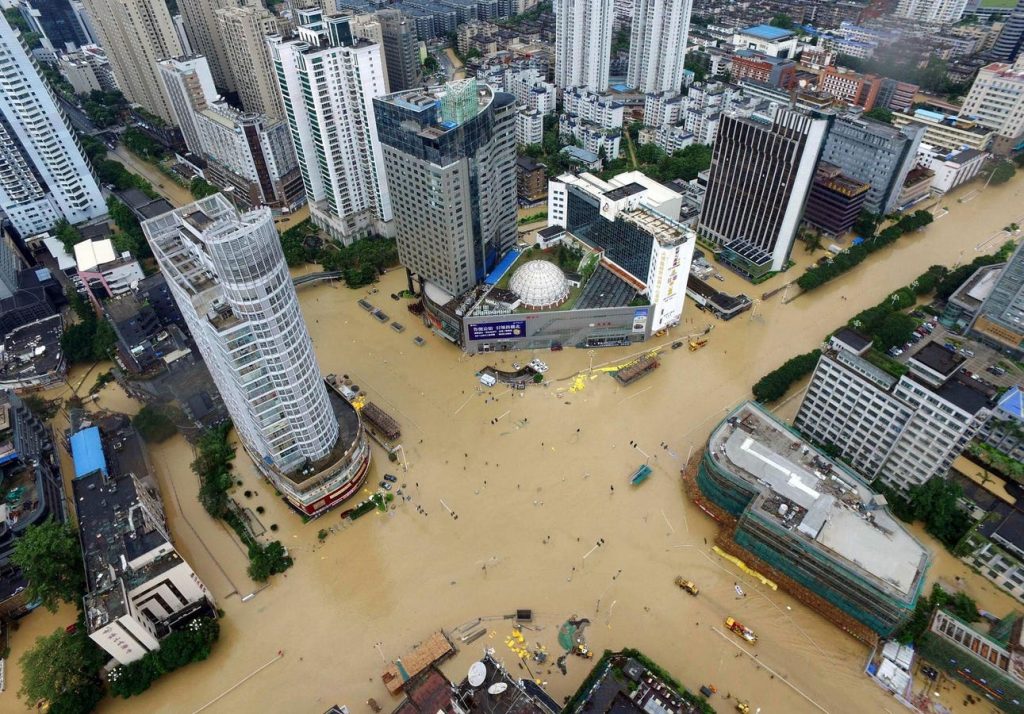Three new research papers all point to a worrying conclusion
I hadn’t planned to write about urban flooding in this column. I’ve touched on the subject several times in the past (e.g.1, e.g.2), and will no doubt return to it again in future. But then I came across three open-access papers, all published this week, within a couple of days of each other. They have no authors in common, they come from disparate research areas, and each one is found in a different journal. But, together, they paint a worrying picture of the threats to coastal urban landscapes in our warming world.
The first thing to say is that the overwhelming majority of the world’s cities are found within 100 km of a coastline. The exact statistics on this vary, but it’s generally agreed that somewhere in the range of 50-60% of the global population can be considered “coastal”, with as many as 347 million people living on low-lying coastal land, less than 2 m above sea level. This makes cities particularly vulnerable to sea level rise and the increasing severity of storms. And yet, very few of them have been built to withstand such events. Instead, most have grown over decades or centuries, with little (or no) attention paid to their inherent vulnerability, both in terms of the inevitable damage to homes and infrastructure and the loss of human life that comes with major floods.
You don’t need to look very hard to find recent news headlines reporting on tragic flooding events. Cities as diverse as Zhengzhou, New York, Auckland, Orenburg, and Mumbai have all been badly hit in the past couple of years. In all cases, the impact of those floods has been worsened by the design of those cities and the impermeable materials used in their construction. It looks set to get worse.
Compounding effects
The first paper of the trio is from researchers at the Hong Kong Polytechnic University. They have shown that concurrent heatwave and extreme sea level rise (CHWESL) events are getting significantly more common in coastal areas. A CHWESL event is when a heatwave and short-term flooding happen in the same location at the same time. A well-documented example of this was in August 2021, when extreme flooding struck the Mediterranean region while local temperatures reached 48.8°C.
Looking at ocean, weather and climate data from 1979 to 2017, this paper’s co-authors found that close to 88% of the world’s coastlines experienced such an event during that period, with tropical coastlines experiencing a disproportionate fraction (70.3%) of those events. There was, however, a marked difference between the first and the second half of that study window. When considering the number of CHWESL days within a year, they found an average increase of 3.72 days during 1998–2017 compared to 1979–1998. In other words, they’ve been happening more frequently in recent years.
The authors discovered a significant association between heatwave intensity and the probability of a CHWESL event occurring. For every 1% more intense a heatwave gets (i.e. increasingly hot and humid conditions), we see a 2% increase in the likelihood of heatwaves that are concurrent with extreme sea levels. It seems that more intense heatwaves – an important climate change indicator – may amplify the risk of a CHWESL event happening.
The final part of the study involved looking ahead; projecting what might happen under different climate change conditions. In the worst case, under the highest emissions scenario (known as SSP5-85), the authors say that global coastal areas could experience, on average, 38 days of CHWESL conditions per year between now and 2049.
‘Natural’ defenses?
The second paper on my list explores the options for defending our coastal cities from flooding events. Led by the University of Tokyo, the study looked at four classes of defense – natural environments (e.g. mangroves, seagrass beds, coral reefs, and tidal marshes), soft measures (e.g. sand dune nourishment, or other options that restore or enrich natural systems); hard measures (e.g. levees and concrete sea walls); and hybrid systems that combine hard and soft elements.
The authors reviewed more than 300 research papers and other high-quality publications (e.g. conference proceedings and doctoral dissertations) to carry out a meta-analysis on each of these coastal adaptation options. They wanted to compare their performance on three metrics:
- Risk reduction – the reduction in wave height and energy that the option provided, plus any measurable impact it had on the shoreline’s stability.
- Climate change mitigation – the ability of the adaptation option to store carbon and reduce GHG emissions.
- Cost-effectiveness over a 20-year period – the monetary costs and benefits of the adaptation option.
Lead author Lam Thi Mai Huynh explained their findings, “Our results indicate that among all coastal defense options in lower-risk areas, hybrid measures provide the highest risk reduction. Hybrid measures can harness the advantages of both hard and soft measures. They provide the immediacy of an engineered barrier while largely maintaining the ecological functionality of a permeable vegetated zone.”
Unsurprisingly, in terms of storing carbon, natural habitats were found to be the most effective option. Soft and hybrid measures were more cost-effective than hard measures, but all coastal defense options had a positive economic return over a 20-year period.
Another major paper published just last month in Nature suggests that building defenses may not be sufficient to avoid a flooded future. Led by Virginia Tech researchers, the study examined the flooding potential for 32 major US coastal cities. The team showed that even when taking coastal-defense structures into account, the combination of land subsidence and sea-level rise is putting an increasing proportion of the population at risk.
The authors say that if no additional preventative steps are taken, 1 in 50 people (up to 500,000 individuals) in US coastal cities could experience flooding within the next 30 years, leading to damages that could exceed $100 billion. The same paper showed that in many of these cities, a disproportionate share of the damage will be shouldered by minority and low-income groups.
Pedestrian-safe streets
The third paper published this week is a bit more niche. It asked one specific question – how does urban design contribute to pedestrian safety during a flooding event? Published in the journal Physics of Fluids, the study combines experiment and simulation.
They started by installing a 3D-printed, human-shaped dummy inside a flume, or flow tank. By varying the speed of the water and wind (generated by a fan) rushing past the dummy, and measuring its response, they could identify the flood and wind conditions that would cause an average pedestrian to fall over, rendering them vulnerable.
They then developed computer simulations with different city block patterns, street widths, and building dimensions and shapes, to assess the configurations that kept those dangerous conditions to a minimum. The goal was to identify what urban form factors could be altered to better protect pedestrians during extreme weather events.
They found that when buildings are arranged in a line, they provide a ‘zone of safety’ by blocking some of the water and wind. In contrast, buildings that were staggered or offset produced ‘danger zones’, where windspeeds are accelerated (via the Venturi effect) and floodwaters become unstable.
Changing the shape of the building also had an impact on pedestrian safety. For example, buildings with rounded or recessed corners produced much smaller areas of ‘extreme risk’ in their wake, compared to buildings with 90° corners. The same was true for triangular buildings. This suggests that non-square buildings might lead to significantly safer conditions for pedestrians during a flood event.
Their final finding was that different building height arrangements can help mitigate the negative impacts of wind, but conclusions on this were less straightforward, as author Zhong-Fan Zhu explained, “In some cases, the floodwater does not cause pedestrian instability, but adding the wind force will lead to a dangerous situation. However, in other cases, the wind will help to maintain pedestrian stability and protect against floodwater. It seems like that wind is like a ‘double-edged sword.’”
What these papers point to is a future that few cities are fully prepared for. One in which urban flooding becomes more frequent and intense, putting a growing number of urbanites at risk. The good news is that we already know exactly how to avoid this fate – by urgently reducing our reliance on fossil fuels, investing in lower-impact, more permeable urban form, shoring up our hard coastal defenses, and restoring those that protect us naturally. So, what’s stopping us?
Read the full article here









